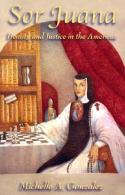Issue Date: May 21, 2004
The Mexican poet's literary value is only part of her intellectual contributions Reviewed by GEORGINA SABAT DE RIVERS To the many enthusiastic readers of Sor Juana Inés de la Cruz, we may now add the author of this book, who demonstrates her familiarity with some of the previous studies devoted to the Mexican nun and poet, especially George Tavard’s Juana Inés de la Cruz and the Theology of Beauty. Michelle Gonzalez analyzes Sor Juana’s works from a theological point of view, an approach that is not too common. Her book consists of the following chapters, each of them thematically subdivided: “Setting the Stage,” “Sor Juana Inés de la Cruz,” “Beauty,” “The Good,” “The True,” “The Organic Unity of Beauty and Justice,” and a “Conclusion: Sor Juana Inés de Cruz, Latin American Church Mother,” a bibliography and an index. This book is a revised thesis in which the author “discovered” Sor Juana and her works as a figure in the history of theology and as an intelligent religious woman who had battled against the limitations that life in the 17th century imposed upon her. Gonzalez’s purpose is to make known the voices that have been ignored because of the “marginalization of Latin American culture, literature and scholarship.” Sor Juana’s poetry, theater and prose, the author believes, challenges Octavio Paz’s assertion that Latin America has nothing equivalent to the philosophical tradition of Western thought; and this challenge is valid not only for the nun’s own time but continues into the present with liberation theology and American feminism, black and Latina movements. Gonzalez, an assistant professor of theological studies at Loyola Marymount University, pays special attention to the relation between literature and theology, since Sor Juana uses forms of writing that are highly literary. According to Gonzalez, Sor Juana joins, in this way, the marginalized voices that have been recuperated by liberation theologians. Chapter 1 presents the historical reputation of Sor Juana, emphasizing how her intellectual work was forgotten for centuries while her literary values were still recognized. In recent years women’s studies have rediscovered her importance to some extent, but this is insufficient if one takes into account the extraordinary variety of intellectual aspects that can be found in her life and works. Chapter 2 traces the life of Sor Juana in her baroque world, beginning with her own works and then taking up more recent studies. We see her moving among the philosophical and theological debates taking place in 17th-century New Spain. The center of the author’s theoretical interest in the nun is found in Chapters 3 and 4; here she studies the transcendental roles played by “Beauty, the Good, and the True.” The auto sacramental play titled “Divino Narciso” is used by the author in Chapter 5 to show the importance of certain theological ideas for Sor Juana. Michelle Gonzalez, however, does not pay sufficient attention to Sor Juana’s work that “most mirrors the male theological voice,” the Carta atenagórica, concerning Christ’s greatest gifts to mankind. The author does tell us that the nun, in her poetry, theater and prose, is concerned with the marginalization of women, Indians and blacks. With Chapter 5, the book could come to an end, but the author goes on to study Sor Juana’s epistemology as found in several of her works. Chapter 6 recapitulates ideas of the good and beauty, relating them to the aesthetics of contemporary theology of liberation in the American world. This is a new way of studying Sor Juana: Latina and black theology, Euro-American theology based on the interrelation of aesthetics and ethics in modern thought. Finally, Chapter 7 suggests a series of approaches deriving from Sor Juana’s theology that could lead to future work in these fields. The notes are generally useful and correct, but there is a mistake on Page 128 concerning a passage in the Reply, according to which Sor Juana was not allowed to study for three months: it was not the Inquisition, but a “simple-minded” mother superior, who ordered this prohibition. The bibliography is extensive, but one does note the absence of such important Sor Juana specialists as Antonio Alatorre, José Pascual Buxó and Antonio Rubial, among others. The index is of course useful. There are a few misprints: “turda” instead of “turba,” “Arrango” instead of “Arango,” “de a” instead of “de la.” In any case, this is a book of interest to anyone studying Sor Juana’s works; in it we find aspects of the nun’s writings that have not usually been studied. Georgina Sabat de Rivers is professor emerita of the State University of New York at Stony Brook. National Catholic Reporter, May 21, 2004 |
